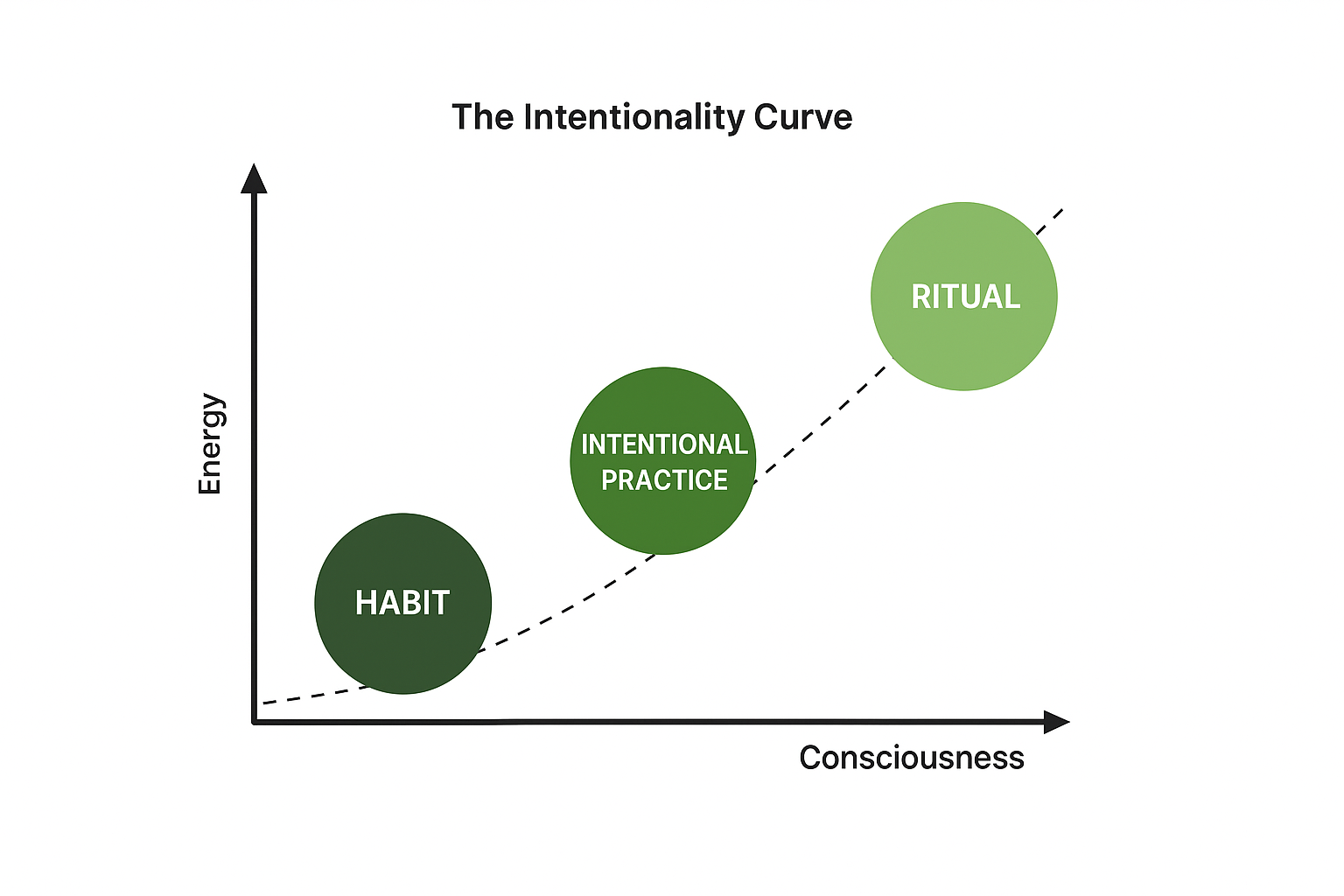Habits to Rituals: Two Approaches to An Intentional Life

Design Your Day Before It Designs You
Most of us wake up and tumble straight into the day — responding to messages, ticking off tasks, running from one thing to the next. It’s easy to feel like we’re just keeping up, not consciously steering.
But what if your day — and your week, and your life — could be shaped more intentionally?
That doesn’t mean rigid schedules or perfect morning routines. It means choosing what really matters to you — your values, your goals — and designing your rhythms to reflect them.
That’s where habits and rituals come in.
You’ve probably heard plenty about the power of habits from authors like James Clear and BJ Fogg. Rituals? Maybe, less so. They are slower, more soulful. But both are tools for living purposefully. It’s helpful to understand the difference.
- Habits are small, repeated actions that make our responses more automatic.
- Rituals are deliberate practices that make our discussions more meaningful.
Let’s explore the difference.
From Deliberate Practice to Habit or Ritual
Every day, we repeat dozens (if not hundreds) of actions — some mindless, some more deliberate. The key to more intentional living isn’t about rejecting this automation — it’s about designing the right mix of automated and meaningful behaviors.
Most new behaviors start with conscious effort - a deliberate routine or intentional practice. Think: going to the gym, cooking dinner, walking the dog. They require effort and intentionality to make them happen.
From there, a behavior can evolve in two directions:
- Habits live at the low-intentionality end. They’re efficient, automatic, and triggered by cues. Think: brushing your teeth, opening Slack, lacing up your shoes.
- Rituals live at the high-intentionality end. They’re deliberate, repeated acts imbued with meaning. Think: starting a team meeting with gratitude.
The thing we sometimes forget is that both start the same way: with effort. Unlocking the desire to make this effort remains important.
Why Most Habits Start as Deliberate Practice
A lot of habit-building advice skips the hard part — the friction-filled beginning. It implies habits just “stick” if you do them enough. But most habits begin as deliberate routines. They require intention, repetition, and usually a framework like:
- An anchor (a reliable trigger)
- A behavior (small enough to repeat)
- A reward (to reinforce the loop)
In some cases, eventually, your brain may take a shortcut. The behavior becomes automatic. That’s when the habit loop kicks in — how brushing your teeth stopped being a chore and became just what you do.
Rituals: When Meaning Becomes the Point
While habits aim for efficiency, rituals aim for significance.
“Make a delicious bowl of tea… arrange the flowers as they are in the field… prepare for rain… and give those with whom you find yourself every consideration.” - Soshitsu Sen, Grand Master of the Japanese Tea Ceremony
The Japanese tea ceremony is powerful because it resists efficiency. It’s about attention and presence. Through repeated choreography, it transforms ordinary acts — boiling water, pouring tea — into something sacred.
We can bring that principle into everyday life:
- Eating becomes a moment of collective calm, discussion and gratitude.
- A meeting opens with a moment of shared intention.
Rituals don’t start magical — they become meaningful through repetition and presence. Over time, meaning accrues.
The Intentionality Curve
Adapted from Ness Labs comes a helpful model: the Intentionality Curve.

The starting point for most habits and rituals is the same: intentional practice. You make a conscious decision — “I’ll do this at that time.”
From there, the practice can evolve in one of two directions:
The practice automates into a habit; Use cues, repetition, and rewards to reduce friction. Example: You decide to stretch for five minutes every morning after brushing your teeth. Over time, it becomes automatic — you don’t even think about it. It just happens, like muscle memory. That’s a habit.
The practice elevates into a ritual; Add presence, intention, and emotional significance.
Example: You decide to reflect and journal each evening with a cup of tea. You reflect on your day, reset your mood, and connect with your values. It becomes a ritual — not because it’s efficient, but because it’s meaningful.
The real power lies in knowing when to optimize for ease — and when to lean into meaning. Often, that choice depends on two things: How frequent the activity is (daily actions tend to lean toward habits). Whether there’s room to layer on intention, emotion, or reflection
Sometimes we just need life to flow more smoothly. Sometimes we want to feel more deeply connected to what we’re doing. Both are valid. Both are powerful. What matters is deciding what matters to you.
Teams and Rituals: More Than Just Individual Practice
Much of this applies to personal behavior. But rituals are also especially powerful for teams — and that’s where we focus at TeamPath.
Whether it’s a weekly retro, a shared playlist, or a deliberate pause before tough conversations — rituals help build shared meaning, cohesion, and culture. They’re the glue that transforms a group of individuals into a real team.
Final Thought: Design Your Day — Don’t Drift Through It
Every day, you have a choice of where to focus. One way to make that support your values and goals is to design a rhythm of habits and rituals that serve you. Start small. Ask:
- What do I want to make easier?
- What do I want to make more meaningful?
Then shape your day accordingly. In the end, it’s not just what you do — it’s how and why you do it that shapes your life.
Our resources
See how TeamPath can transform your team’s performance today



